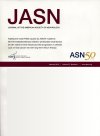External Validation of an Electronic Health Record–Based Diagnostic Model for Histological Acute Tubulointerstitial Nephritis
Individual noninvasive diagnostic tests lack accuracy for diagnosing histological acute tubulointerstitial nephritis.A validated diagnostic model combining four clinical tests accurately predicted acute tubulointerstitial nephritis on biopsy in two separate populations.
Background
Accurate diagnosis of acute tubulointerstitial nephritis (AIN) often requires a kidney biopsy. We previously developed a diagnostic statistical model for predicting biopsy-confirmed AIN by combining four laboratory tests after evaluating over 150 potential predictors from the electronic health record. In this study, we validate this diagnostic model in two biopsy-based cohorts at Johns Hopkins Hospital (JHH) and Yale University, which were geographically and temporally distinct from the development cohort, respectively.
Methods
We analyzed patients who underwent kidney biopsy at JHH and Yale University (2019–2023). We assessed discrimination (area under receiver-operating characteristics curve [AUC]) and calibration using previously derived model coefficients and recalibrated the model using an intercept correction factor that accounted for differences in baseline prevalence of AIN between development and validation cohorts.
Results
We included 1982 participants: 1454 at JHH and 528 at Yale. JHH (5%) and Yale (17%) had lower proportions of biopsies with AIN than the development set (23%). The AUC was 0.73 (95% confidence interval [CI], 0.66 to 0.79) at JHH and 0.73 (95% CI, 0.67 to 0.78) at Yale, similar to the development set (0.73 [95% CI, 0.64 to 0.81]). Calibration was imperfect in validation cohorts, particularly at JHH, but improved with the application of an intercept correction factor. The model increased AUC of clinicians’ prebiopsy suspicion for AIN by 0.10 to 0.77 (95% CI, 0.71 to 0.82).
Conclusions
An AIN diagnostic model retained discrimination in two validation cohorts but needed recalibration to account for local AIN prevalence. The model improved clinicians’ ability to predict AIN.




